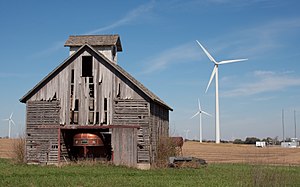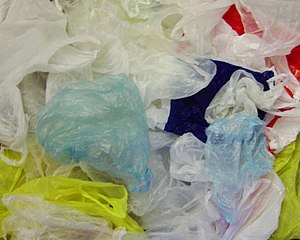 Image via WikipediaBy Charles A Juopperi
Image via WikipediaBy Charles A JuopperiIntroduction
Wind generated electrical power exists through harnessing wind-power energy with turbines. To fully understand wind generated electrical power, one must understand how wind powered electricity is made; resources needed to utilize wind power; types and sizes of wind turbines; building a wind turbine; potential positive and negative impacts of the technology; where wind powered electricity can be effectively generated; and, offsetting the costs of wind powered electrical technology.
How Wind Powered Electricity is Made
The technology of wind generated electrical power functions by creating electricity through the use of various styles of wind turbines. Initially, one might ask, "So how do wind turbines make electricity?" Simply said, a wind turbine works the opposite of a fan. Instead of using electricity to make wind, like a fan, wind turbines use wind to make electricity. The wind turns the blades, which spin a shaft, which connects to a generator and makes electricity.
Resources Needed to Utilize Wind Power
The primary resource of Wind powered technology is, of course, wind. Wind is very abundant in many parts of the United States and other parts of the world. Wind resources are branded by wind-power density classes, ranging from class 1 (the lowest) to class 7 (the highest). Good wind resources (e.g., class 3 and above, which have an average annual wind speed of at least 13 miles per hour) are found in many areas. Wind speed is a critical of wind resources, because the energy in wind is proportionate to the cube of the wind speed. In other words, a stronger wind means more power.
Wind resource development requires land and may compete with other uses of that land, and those alternative uses may be more highly valued than electricity generation. However, wind turbines can be positioned on land that is also used for grazing or even farming. Wherever a wind farm is to be built, roads are cut to make way for shipping parts. At each wind turbine location, the land is graded and the pad area is leveled. Wind energy also requires the building of wind turbines.
Types and Sizes of Wind Turbines
Modern wind turbines fall into two basic groups: the horizontal-axis variety and the vertical-axis design, like the eggbeater-style Darrieus model, named after its French inventor. Horizontal-axis wind turbines typically either have two or three blades. These three-bladed wind turbines are operated "upwind," with the blades facing into the wind. Darrieus models, or vertical-axis wind turbines, have two vertically oriented blades revolving around a vertical shaft.
In addition to different types, there are many different sizes of wind turbines. Utility-scale turbines range in size from 100 kilowatts to as large as several megawatts. Larger turbines are grouped together into wind farms, which provide bulk power to an electrical grid. Single small turbines, below 100 kilowatts, are used for homes, telecommunications, or water pumping.
Small turbines are sometimes used in connection with diesel generators, batteries, and photovoltaic systems. These systems are called hybrid wind systems and are typically used in remote, off-grid locations, where a connection to the utility grid is not available.
Building a Wind Turbine
The first step in building a wind turbine is setting up the tower where the fiberglass nacelle is installed. The nacelle is a strong, hollow casing that contains the inner workings of the wind turbine. Usually made of fiberglass, the nacelle contains the main drive shaft and the gearbox. Its inner workings also contain blade pitch and yaw controls. The nacelle is assembled and attached onto a base frame at a factory.
The most diverse use of materials and the most experimentation with new materials occur with the blades. Although the most dominant material used for the blades in commercial wind turbines is fiberglass with a hollow core, other materials in use include lightweight woods and aluminum. Wooden blades are solid, but most blades consist of a skin surrounding a core that is either hollow or filled with a lightweight substance such as plastic foam or honeycomb, or balsa wood.
Wind turbines also include a utility box, which converts the wind energy into electricity and which is located at the base of the tower. The generator and electronic controls are standard equipment whose main components are steel and copper. Various cables connect the utility box to the nacelle, while others connect the whole turbine to nearby turbines and to a transformer.
Potential Positive and Negative Effects of Wind Powered Electricity
There are a variety of potential positive and negative impacts of wind powered technology.
Potential positive impacts include:
- Wind energy is friendly to the surrounding environment, as no fossil fuels are burnt to generate electricity from wind energy.
- Wind turbines take up less space than the average power station. Windmills only have to occupy a few square meters for the base; this allows the land around the turbine to be used for many purposes, for example agriculture.
- Newer technologies are making the extraction of wind energy much more efficient. The wind is free, and we are able to cash in on this free source of energy.
- Wind turbines are a great resource to generate energy in remote locations, such as mountain communities and remote countryside.
- Wind turbines can be a range of different sizes in order to support varying population levels.
- When combined with solar electricity, this energy source is great for developed and developing countries to provide a steady, reliable supply of electricity.
Potential negative impacts include:
- Wind turbines generally produce less electricity than the average fossil fuelled power station, requiring multiple wind turbines to be built.
- Wind turbine construction can be very expensive and costly.
- Wind turbines can have a negative impact to surrounding wildlife during the build process.
- The noise pollution from commercial wind turbines is sometimes similar to a small jet engine.
- Protests and/or petitions usually confront any proposed wind farm development. People feel the countryside should be left intact for everyone to enjoy its beauty.
Where Wind Powered Electricity Can be Effectively Generated
Places in the world where wind blows strong and often, people and businesses can harness the wind as an option to use in the generation of electricity. Globally, these places include much of North America, southern South America, Greenland, most of Europe, Northern Africa, eastern Asia, most of Australia, and anywhere there are mountains or large hills. The top 5 countries producing electrical wind power in 2007 were: Germany, United States, Spain, India and China, respectively.
Considerable wind speeds also occur across oceans and large water bodies. Since most of the world's population lives near oceans, wind farms with strong offshore and onshore breezes could produce an abundant amount of electricity. On land in the USA, the major wind corridor is the Great Plains which includes the states of North Dakota, South Dakota, Nebraska, Kansas, Oklahoma and Texas.
The wind corridor also extends into the states west to the great mountains west, including eastern Montana, Wyoming, Colorado, and New Mexico. There are also considerable wind resources in eastern and southern Minnesota and the entire state of Iowa, diminishing south through Missouri and east through southern Wisconsin and northern Illinois, Indiana and Ohio. Parts of New York and the New England states also have considerable wind.
The Department of Energy (DOE) estimates that wind power could supply the US with 100% of its electricity, just from the Great Plains wind corridor or from offshore wind farms alone. According to the "Pickens Plan," a $10 billion wind farm with 2500 generators can supply enough energy for 1.3 million homes, and for $1 trillion the Great Plains wind corridor could supply 20% of America's electricity. That would be about 250,000 generators to supply 130 million homes.
In a report published by the U.S. Department of Energy, "20% Wind Energy by 2030: Increasing Wind Energy's Contribution to U.S. Electricity Supply," that report concluded that:
- Reaching 20% wind energy will require enhanced transmission infrastructure, streamlined siting and permitting regimes, improved reliability and operability of wind systems, and increased U.S. wind manufacturing capacity.
- Achieving 20% wind energy will require the number of turbine installations to increase from approximately 2000 per year in 2006 to almost 7000 per year in 2017.
- Integrating 20% wind energy into the grid can be done reliably for less than 0.5 cents per kWh.
- Achieving 20% wind energy is not limited by the availability of raw materials.
- Addressing transmission challenges such as siting and cost allocation of new transmission lines to access the nation's best wind resources will be required to achieve 20% wind energy.
Offsetting the Costs of Wind Powered Electrical Technology
Although wind generated electrical power seems to be an unlimited resource, and, the best wind sites appear to be competitive with market electricity prices in most U.S. regions, several factors exist that make it a less appealing source of alternative energy in terms of economic cost. First off, wind is not uniformly priced resource. Its costs vary widely depending on project scale, wind speed, region, and other factors. Second, the benchmark for comparison with wind to other fuels varies regionally. Third, extra revenue is required to make a project viable, sunk costs are considerable.
To offset the factors that make wind powered electricity a less appealing source of alternative energy and promote its continued growth, wind energy in many areas receives some financial or other support to encourage development. Wind energy benefits from subsidies either to increase its attractiveness or to compensate for subsidies received by other forms of production, such as coal and nuclear, which have significant negative impacts.
In the United States, wind power receives a tax credit for each Kilowatt hour produced; that was 1.9 cents per Kilowatt hour in 2006. The tax the credit has a yearly inflationary adjustment. Many American states also provide incentives, such as exemption from property tax, mandated purchases, and additional markets for "green credits." The Energy Improvement and Extension Act of 2008 contain extensions of credits for wind, including micro-turbines.
Secondary market forces also provide incentives for businesses to use wind-generated power, even if there is a premium price for the electricity, socially responsible manufacturers pay utility companies a premium that goes to subsidize and build new wind power groundwork. Companies use wind-generated power, and in return they can claim that they are making a "green" effort.
Undoubtedly, further tax credits, subsidies and incentives will also be needed to achieve the goal of 20% Wind Energy by 2030. Today, wind power approximately accounts for about 2% of the electricity generated in the United States.
Summary
The technology of wind generated electrical power functions by creating electricity through the use of various styles of wind turbines is a very viable alternative energy. Although wind generated electrical power does have some negative impacts, this author feels that in terms of long-term cost and benefit compared with other types of energy, such as the burning of fossil fuels, using a renewable resource such as wind generated electrical power economically, environmentally, and socially is making more and more sense.
Charles Juopperi invites you to do your part in energy conservation by purchasing Green, ROHS, and Energy Star compliant products at his website eDiscount Electronics: http://stores.ediscount-electronics.com. When you buy products from us, you can rest assured that your doing your part for the environment while finding the lowest prices around. eDiscount Electronics sells discount wholesale desktops, servers, notebooks, tablets, audio equipment, HDTV's, and other types of consumer electronics. Please visit us today. Orders over $1000 ship free!
Article Source: http://EzineArticles.com/?expert=Charles_A_Juopperi
http://EzineArticles.com/?Defining-Wind-Generated-Electrical-Power-and-Discussing-Pros-and-Cons-of-the-Technology&id=6770264






